Re-Admission to Orthopaedics Department in Salford Royal Foundation Trust Hospital Results of Local Audit
Imad Madhi, Ahmed Aljawadi*, Mohammed Elmajee, Mohammad Badr Almoshantaf, Anand Pillai and Ihab Butrus
Trauma and Orthopaedics, Wythenshawe Hospital, UK
Submission: September 04, 2019; Published:November 20, 2019
*Corresponding author:Ahmed Aljawadi, Trauma and Orthopaedics, Wythenshawe Hospital, Manchester, M23 9LT, UK
How to cite this article:Imad Madhi, Ahmed Aljawadi, Mohammed Elmajee, Mohammad Badr Almoshantaf, Anand Pillai. Re-Admission to Orthopaedics Department in Salford Royal Foundation Trust Hospital Results of Local Audit. J Phy Fit Treatment & Sports. 2019; 7(2): 555710. DOI: 10.19080/JPFMTS.2019.07.555710
Abstract
Readmissions after Orthopaedics operations are common. These re-admissions increase the risk of other complications, such as prolonged hospital stay, infections, and thromboembolic complications, as well as poses a very high costs, thus, reducing admissions is targeted to assessment. This paper is addressing the Readmission Audit that was undertaken at Salford Royal Foundation Trust, Manchester, UK at the Orthopaedics Department by assessing readmission rate to Orthopaedics department for both elective and emergency patients, identifying patterns in causes, and evaluating high-risk readmissions. It was found that patients aged more than 65 years and with those co-morbidities are at a higher risk of readmissions. Furthermore, the most common postoperative complication that might lead to further admission is infections. Patient discharge planning and a proper, thorough review before discharge can affect the readmission rates, especially if complications were identified early.
Keywords:Salford royal foundation trust; Co-morbidities; NHS organizations; Clinical audit; Orthopaedics operation; Electronic notes; Trauma; Medication overdose
Introduction
The NHS Organizations produced a system called “Clinical Governance” through which the NHS organization is responsible for continuously improving the quality of their services and safeguarding high standards of care. An important element of the system is better known as the “Clinical Audit”, that is a process that seeks to improve the overall patient care and outcomes through a systematic review of care against explicit criteria and the implementation of change, as it provides the mechanisms to review the quality of care provided, and further offer mechanisms to address such issues, as well as the formation of plans to improve practice. A further process better known as “Recycle the Audit” that aims to re-assess the same issues after a period to ensure plans have been practiced. This process should be closed after implying all the action plans for improvement as described in (principle of best practice in clinical audit) [1]. The Orthopaedics Department is considered very active compared to other specialties, and through the development of medical practice as well as the new techniques of quality of care, patient full recovery rate is higher than previous years. Readmissions after Orthopaedics operation emergency or elective are common and can indicate that patients are either not fully recovered or have developed postoperative complications. However, these re-admissions increase the risk of other complications, such as prolonged hospital stay, infections, and thromboembolic complications, as well as very high costs to readmission. After new policies of trust, readmissions of these patients indicate failure of treatment and subsequently losing the cost of primary operation. As a result, this new policy adds an extra burden on the department to find proper mechanisms and better overall care to avoid these expenses. Thus, all medical centers have targeted reducing readmission as a step to improving health care and reducing costs. In Orthopaedics Surgery, many factors are essential for patient full recovery, following operations which include pre-operative planning, recognition of patient early and late complications, and post-operation non-surgical care, as most of these patients have a background of medical problem that increases the risk of post-operation complications. The most common post-operation complications include infections, respiratory and wound infections, pain, ischemic, deep venous thrombosis, pulmonary embolism, and urinary retention [2]. The paper will be addressing the Readmission Audit that was undertaken at Salford Royal Foundation Trust at the Orthopaedics Department, as admissions reached up to five thousand cases annually in the last few years (which subsequently increased readmission rates) with different Orthopaedics problems, both elective and emergency. As a result, the increase of pressure on the trust to reduce readmission rate for both clinical and financial reasons, resulted in an increased awareness to conduct an audit to assess readmission in this department and provide mechanisms to reduce future readmissions. During the last year, a similar audit that was previously conducted had limited changes that did not completely address the main issues of the problem. The aim of this audit is to focus directly on the issues observed from the previous patient data readmitted to the Orthopaedics department via:
a. Assessing readmission rate to the Orthopaedics department for both elective and emergency patients.
b. Identifying patterns of readmission in causes.
c. Evaluating patients at high risk of re-admission.
Literature Review
However, most of the literature conducted to find the main reason for readmission, though in reviewing most of these papers it was difficult to find fixed reasons associated with all readmission as it revealed [2] published a paper study the risk factors of readmission. It was a retrospective cohort study examining 3264 Orthopaedics admissions in a total of 2 years’ time. Using patient data recorded in their admission, the study recognized two main associated risk factors of readmission are multiple co-morbidities and associated social-economic state of patients. Other reasons shown in the results of the study was a high rate of surgical site infection as it accounted for 34% of the readmission. Furthermore, [3] published a study examining hospital readmission after discharge for patient with hip fracture: Surgical and nonsurgical causes and their effect on the outcome of operations. It was prospective, multisite, observational cohort study, 562 patients in one-year time between 1997 and 1998, the study examined the main causes of hospital readmission after hip Operation the results of the study showed surgical complication accounted for 11% of all readmission. While the highest causes of both surgical and non-surgical readmission were infection by 25%. The non-surgical causes were higher especially for chest and heart problem by 16% of the 2 causes together. Another study examining readmission after total hip replaced took place in Stepping Hill Hospital [4] as they looked at specific post-operative complication and compared their numbers to the national rate. Their study showed the highest rate of readmission recorder to dislocation, swelling of the legs, and infection. However, most of the data showed incorrect coding and the complication rate are as expected from a similar operation. These literatures indicate the possibility of variation in readmission causes and complication ratio by time, place of study, and variables considered by the researcher [5].
Methodology
Medical practitioners at the Department of Trauma and Orthopedics at Salford Royal Foundation Hospital performed the audit. Strategies of collection and methodology were developed from methodology guidance recommended by NICE guideline. Furthermore, audit tools were formed after reviewing the most common causes of complication that might have led to readmission, in addition to reviewing the data to find the most common causes shared between these readmissions. The target of the audit was recommended by the management team at the Orthopaedics Department in order to establish minimal bias that might affect the outcome of the audit. Moreover, this audit is considered prospective as the number of the patients was selected in advance following a period. The numbers and the period selected after the changes applied from the first audit, a total number of 82 patients were randomly selected who were readmitted to the Orthopaedics Department at Salford Royal Foundation Trust during a total of six consecutive months, which began in April 2012 and lasted until October 2012. Moreover, the sample size and the time scale were decided for the minimum population needed to show changes to the practice if needed. The data collected are quantitative as it dealt directly with incidence and rates of the events following the operation from patient notes and outcomes following the admission and readmission. Out of those 82 patients, 28 of them had elective operation, while the remaining 54 were readmitted after an emergency operation. All sources of readmission were accountable including accident and emergency, general practice and outpatient department. The data sources were collected from patient notes (electronic notes), electronic discharge records, general practice letters, and medication prescription and PACK system “Electronic radiology investigation results used in Sanford Royal Foundation Trust Hospital”. The data collection form has been designed to include data from both the first and the second admission and included the generally known causes of both admissions. The first reason of admission was recorded and included the length of stay and any events noticed while the patient was at the hospital. However, the reasons for readmissions were divided into three major categories in order to simplify the analysis of the data:
a. Patient readmitted due to major Orthopaedics complications that’s to say musculoskeletal problem which is related to the 1st admission as unresolved primary problem or development of complication.
b. Post-operation complication related to primary operation and stay at hospital but non-Orthopaedics like chest, urinary infection or ischemia (it will be discussed in detail in the next paragraph).
c. Other non-related causes not due to the first admission or operation as it could be due to patient medical background or other co-incident of different illnesses.
a. In the first category which includes specifically Orthopaedics complication data sheet included the search of the well-known common complications following major Orthopaedics operation, include:
b. Bleeding and hematoma
c. Infections like wound, joint and metalwork infections
d. Pain-related to the operation site or patient position during operation out of the usual and uncontrolled.
e. Nerve injury or compression.
f. Same Orthopaedics problem of the primary admission or worsening.
g. Miscellaneous or unusual complications. The second category including post-operatio
n complications for non-Orthopaedics are (most common):a. Respiratory infection like hospital acquired pneumonia, respiratory distress or exacerbation of chronic obstructive pulmonary disease
b. Urinary tract infection and urinary retentions. c. Dehydration
d. Thromboembolism like pulmonary embolism, myocardial infection and strokes
e. Medication overdose like Analgesia.
In addition to the recognized type of complications, the audit attempts to identify the patients with high risk of readmission by categorizing them according to their age, gender, patients with multiple co-morbidities before the acute problem, from previously recorded notes. As well, the datasheet included postoperative complications during the 1st admission and sources of the re-admission. Other variables that monitored to identify possible relations to the readmission, included patients’ length of stay during the first and second admissions, and the route of the second readmission. The form was arranged in a separate sheet first including all the variables mentioned above in the methodology. The form has been revised by the specialist supervisor and some changes have been applied according to his advice. After filling the form, all data were transferred to an excel sheet for easier calculation and statistics. The form filled in a confidential way showing patients in numbers and all data were kept in a safe place at the hospital during data collection and permission obtained earlier and registered at the hospital online electronic form. All data collected and revised and then interpreted into descriptive statistics using ratios and percentages for all results, in addition to different graphs used to make results easy to understand, which includes bar charts, histograms, graphs, and pie charts.
Results
The results will show all the variable risk factors and complication rates indicated in the collecting sheet mentioned earlier in the methodology First: Patient risk factors for readmission reveals:
Patient aged more than 65 years were most of the readmissions as the data shows 46% of readmission were between ages 65 and 98 years; while 28% were between 50 and 65 years and 26% between 16 and 50 years of age Figure 1. While gender distribution shows’ 56 %female and 44 %Male from the second admission.as shown in Figure 2. Co-morbidities as the par chart shows the 52%of the patient readmission had multiple comorbidities in compared to their 25% with the chronic problem. Emergency operations have higher re-admission rate in compared to elective, 34% elective 66% emergency shows in Figure 3. According to the type of operation readmission distribution according to the pie chart shows, total knee replacement had 23% readmission, total hip Replacement had 19% of the admission and the rest of the operation distributed equally between 8% to 12% which are statically not important please see Figure 4 and Figure 5. Data calculation results for the reasons of the second admission according to the classification discussed in the methodology into three major categories results distribution shows in Figure 6.
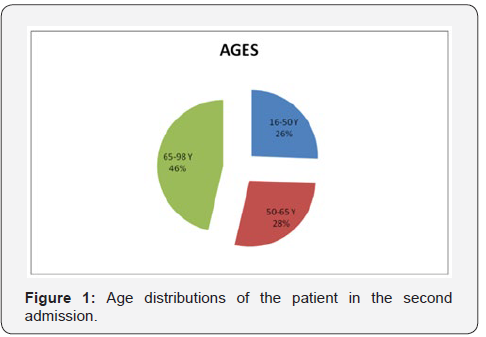
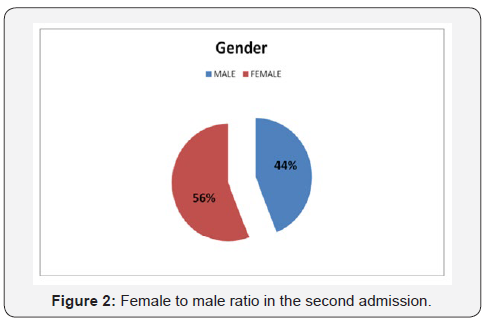
a. Due to major Orthopaedics problem accounted for 59% of all the second admissions
b. Post-operative complication “non-Orthopaedics” resulted in 24% of readmissions
c. The other readmissions, which is not related to the first admission accountant 17% of all the readmissions.
And to look in details of the readmissions first category causes of Orthopaedics complication of the 59 are:
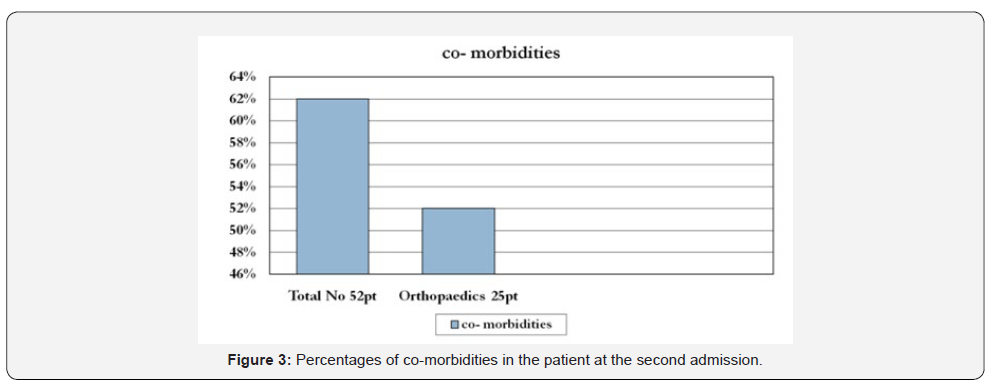

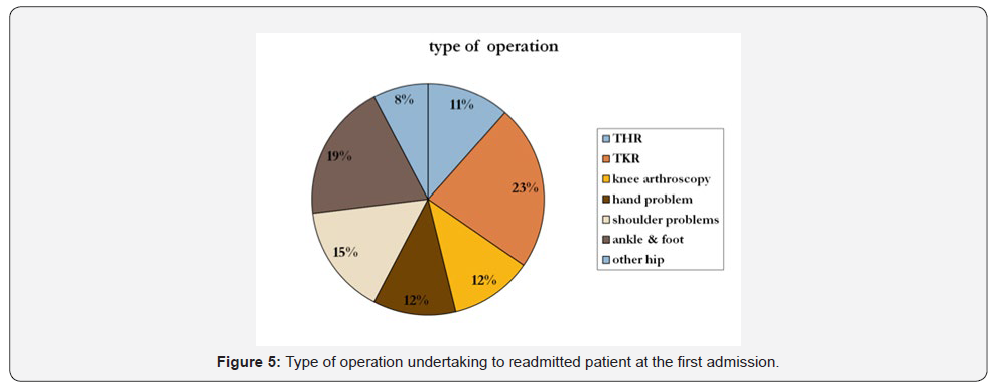
a. Wound or operation site infection 24%
b. Same as the primary complaint “unresolved problem 8%
c. Pain at operation site 4%
d. Post-operative bleeding 2%
e. Swelling at site of operation or operated joint 1%
f. Nerve injury or compression due to the operation or the patient position 3%
g. Other miscellaneous 5%
h. Re-admitted for another elective operation 2 %
In the second categories of non-Orthopaedics complications are Figure 7.
a. Respiratory infections like pneumonia or exacerbation of COPD 8%
b. Urinary tract infection and urinary retention 5%.
c. Dehydration thromboembolism 3%.
d. Analgesia overdose 1%
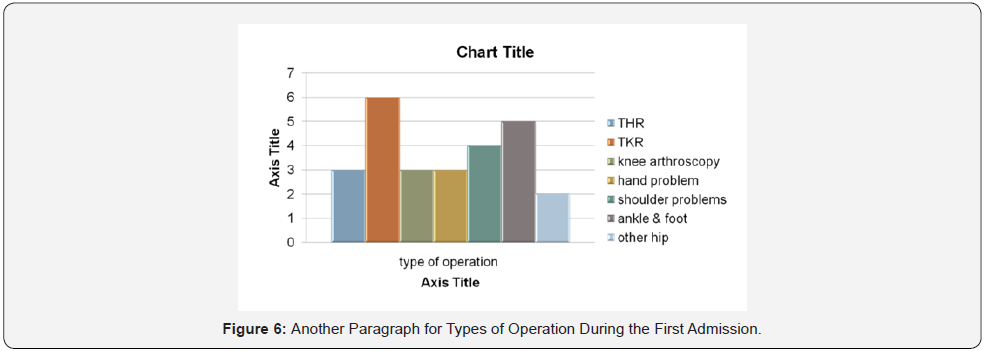
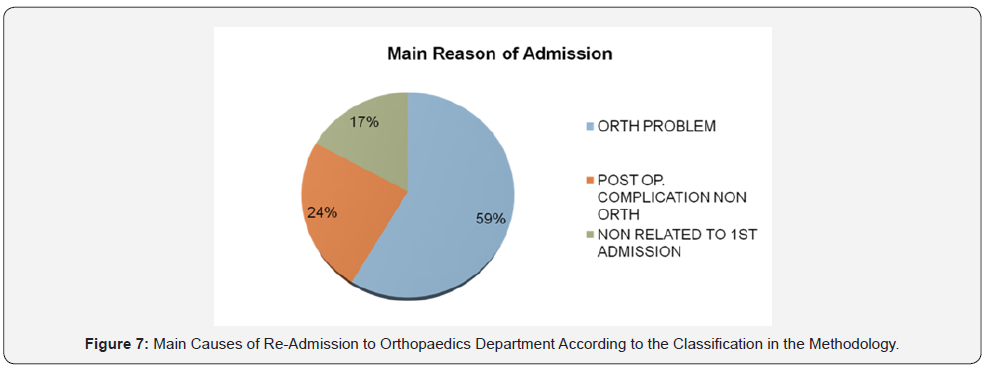
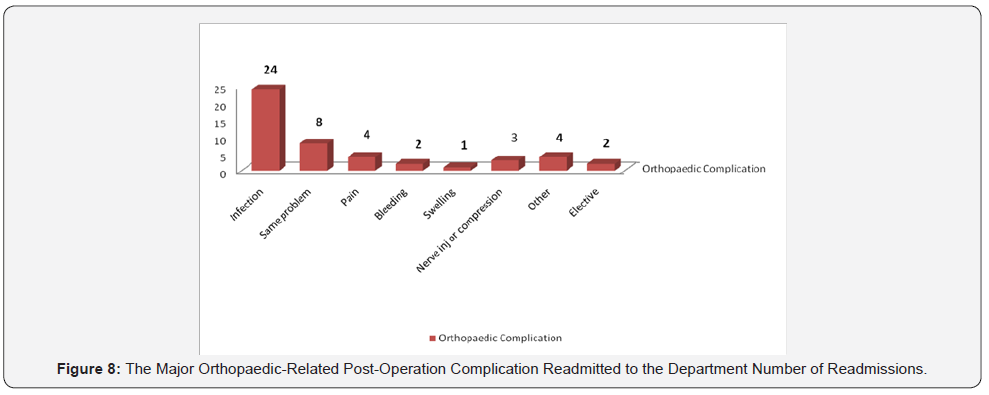
The root of the readmission data shows the main root of the readmission found to be accident and emergency contributed to 67 percent of all the readmissions followed by the general practitioner’s 17 percent and outpatient department 6 percent other 10 percent found to be patient admitted to other specialties then transfer to Orthopaedics for postoperative complications Figure 8.
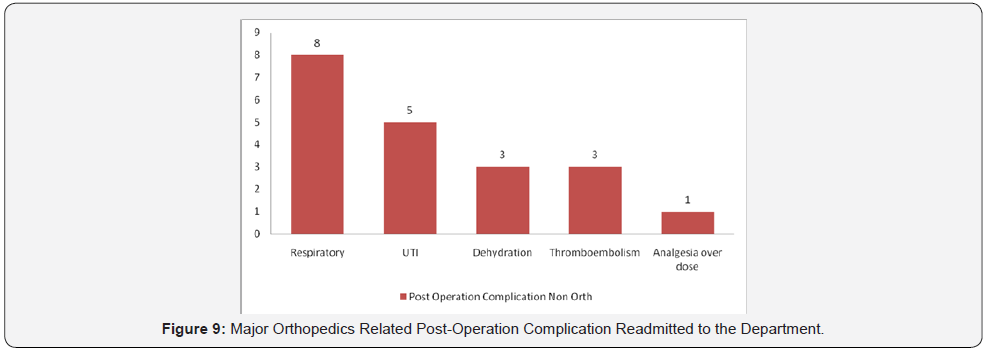
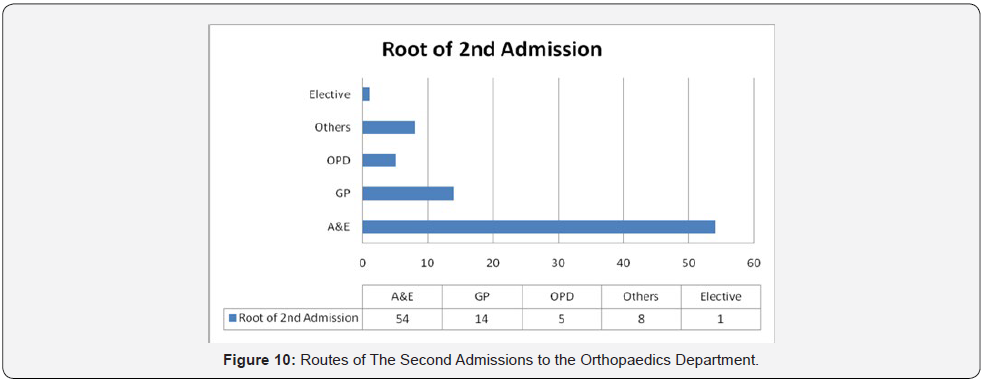
In order to assess genuinely all the readmissions, the result has been calculated the only the patient who had active management during the second readmission Figure 9. As this patient needs to be assessed in detail due to their importance when applying the changes in the future as it shows 35% of patient readmitted needed intravenous antibiotics 38%went to the theatre for operation 27% of the patient treated conservatively or monitored. The length of stay did not show any patterns in compare with the first admission Figure 10.
Discussion
Several factors have contributed to the readmissions following Orthopaedics operation. These factors and complications are well recognized and can be prevented in shortand long-term planning. “Details of recommendations for future proper action to ensure improvement in long- and short-term outcomes will be further discussed below”. Regarding the general risk factors of the admission, it has shown that patients aged 65 years old have a higher rate of readmission (46%) compared to other groups. Consequently, this age group might suffer from higher co-morbidities, which is supported by our findings that showed 52% of patients were readmitted due to comorbidities. Generally, it has been well established that patients who had emergency operations are at higher risk of complications than those with elective operations. Even though, all these recognized risk factors are fixed to change, as the results have revealed the importance of these factors into consideration for more precise review to address any further concerns, as well as to ensure that other medical problems are stable before planning for discharge. Such an approach might help to somewhat lower the re-admission percentage, but with the intention to correct other risk factors and preventing complications, the readmission rate can be reduced significantly. By analyzing other causes of re-admission, it was found that 17% of patients were not true Orthopaedics related, while 24% of patients admitted with non-musculoskeletal post-operative complications. These complications should be recognized earlier before discharging patients from the hospital. They require careful and thorough review of the patients in the hospital, along with frequent assessment and referral to the related specialty Figure 11 & 12.
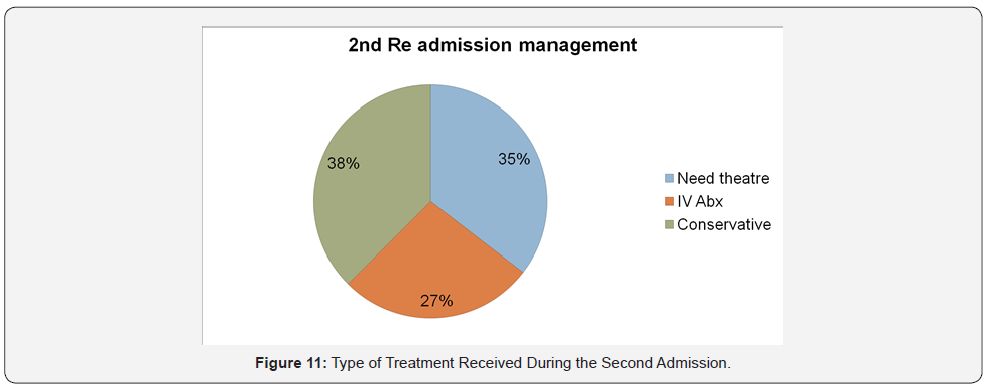

Meanwhile, patients with second admissions should be under the care of other specialties, as they do not require Orthopaedics care due to the origin of their problem. Our data indicated that 40% were readmitted due to respiratory problems, such as hospital-acquired pneumonia, lung collapsed and exacerbation of chronic obstructive pulmonary disease. In addition to a further 25% due to urinary tract infection and urinary retentions; 15% due to dehydration, as well as 15% due to thromboembolism and ischemia, and 5% due to analgesia overdose. Even though the rate of above postoperative complications might be within the expected rate, however, they show the significance of forming a formal full examination and infection screen before discharging along with physiotherapy recommendations and exercise in order to reduce the risks to the minimum. True Orthopaedics readmissions accounted for approximately 59% of all patients readmitted. It was found that 50% of these patients were admitted due to wound, joint or metalwork infections. However, while the numbers are within the expected national rate of postoperative infection, it might be worthy to further study the audit in order to find the best approach to decrease the numbers of readmissions in the future as there are earlier symptoms that can be noticed from patients and signs to reach excellence in patient care and insure full recovery following operation. Furthermore, our data revealed that the second most common cause of the readmissions was due to unresolved primary problem which accounted for 17% of the patients. While post-operative pain is the third common cause (9%), pain could be that of uncontrolled usual postoperative pain and the patient might discharge without enough analgesia or the pain worsening due to the development of other complications. Since pain is resolvable and manageable, such patients require genuine pain review in order to allocate a plan prior to discharge, which can subsequently reduce readmission due to pain. Such plan should involve the pain management team in the discharge, as well as the pain specialist nurse for post-discharge, follow up and managing uncontrolled pain not related to other postoperative complications. Finally, out of all readmissions, it has been found that the accident and emergency department had the highest rate route of readmission (67%), followed by the general practitioners and outpatient department. Even though most of the patients are true admission, however, the minorities of patients who do not need admission have been readmitted through A&E.
An attempt to reduce the number of these patients attending accident and emergency should be set up in order to filter them before arrival to the A&E department. Such plan can be achieved through assembling a helpline to those patients with more specialist team to manage them accordingly, and that will lead to shorter time management, as well as less costs in the future.
Limitations
a. First, the audit was general and lost the ability to focus on specific complications related to the common Orthopaedics operation like total hip replacement, which could give a more specific plan and therefore better future management.
b. Second, all the readmissions assessed were admitted to Salford Royal Foundation Hospital, while not taking in consideration proper follow-up for all patients who had the primary operations at this hospital as some patients could be admitted to other departments or even another hospital.
c. Third, it might be important to consider the social circumstances of the patients and their abilities to have good care after discharge from the department as it might implicate on the risk of complication and readmission.
d. Finally, even if the data were enough to show sides of patient care that need addressing; however, these numbers can be affected if we take it in high scales, especially if we take elective operation in separate to emergency operations.
Summary
Patients aged more than 65 years and with co-morbidities are at higher risk of readmissions. The most common cause of postoperation complication that might lead to further admission is infections, generally. Moreover, patient discharge planning and proper through review before discharge can affect highly if these complications were recorded earlier. Formation of team to follow up these patients in the first 28 days after operation and guidance for better management and earlier treatment could reduce these admissions and provide better short- and longterm care for these patients.
Recommendations
Many factors usually affect the rate of readmissions ,common factors includes quality of post-operative care ,proper followup ,social services interference and ensure safe environment to the patient post-discharge ,and to ensure improvement in readmission rate a well-planned system of communication and collaboration between all these factors can play a rule to reach the goals to resolve the issues. To reduce cost and improve the overall care of the patient rapid applying to changes and taking plans are the main stone of resolving the issue, as the outcome of this audit will recommend.
a. Prior to discharge: Appropriate post-operation assessment and thorough examination before discharge can pick up early complication and better management of the problems.
b. Assess comorbidity: Patients with high risk of complication at easy admission and before discharge.
c. Making a form to tick and assess these patients will make a documentation and follow up of original problems.
d. Ensure correct coding of readmission and prevent unnecessary data error for future studies and audits.
e. Improve Orthopaedics post-operation patient access through allocated team to triage these patients and provide quick help to avoid unnecessary readmission from A&E or GP.
f. Continuous collection of data and having more audits on a larger scale to show forth patterns in readmission and possible improvement following recommendation and changes applied to the practice.
An audit will be recommended in the following areas:
a. Pain management of patients following operation and after discharge.
b. Infection rate following common Orthopaedics operation and protocols used to manage these patients.
c. Appropriateness of the discharge planning and if needed, further improvement in the future.
Allocate pain management team to assess patient pain control post-operation and prior to discharge, make an easy contact point, such as a specialist nurse to provide help lines with further post-discharge help for patients if needed.
References
- Scrivener R, Morrell C (2002) Principles of Best Practice in Clincal Audit. Radcliffe Medical Press Ltd 1-206.
- Cullen C, Johnson DS, Cook G (2006) Re-admission rates within 28 days of total hip replacement. Annals of the Royal College of Surgeons of England 88(5): 475-478.
- Dailey EA, Cizik A, Kasten J, Chapman JR, Lee MJ (2013) Risk factors for readmission of orthopaedic surgical patients. The Journal of bone and joint surgery. American volume 95(11): 1012-1019.
- Stefan MS, Pekow PS, Nsa W (2013) Hospital performance measures and 30-day readmission rates. Journal of general internal medicine 28(3): 377-385.
- Boockvar KS, Halm EA, Litke A (2003) Hospital readmissions after hospital discharge for hip fracture: surgical and nonsurgical causes and effect on outcomes. Journal of the American Geriatrics Society 51(3): 399-403.






























